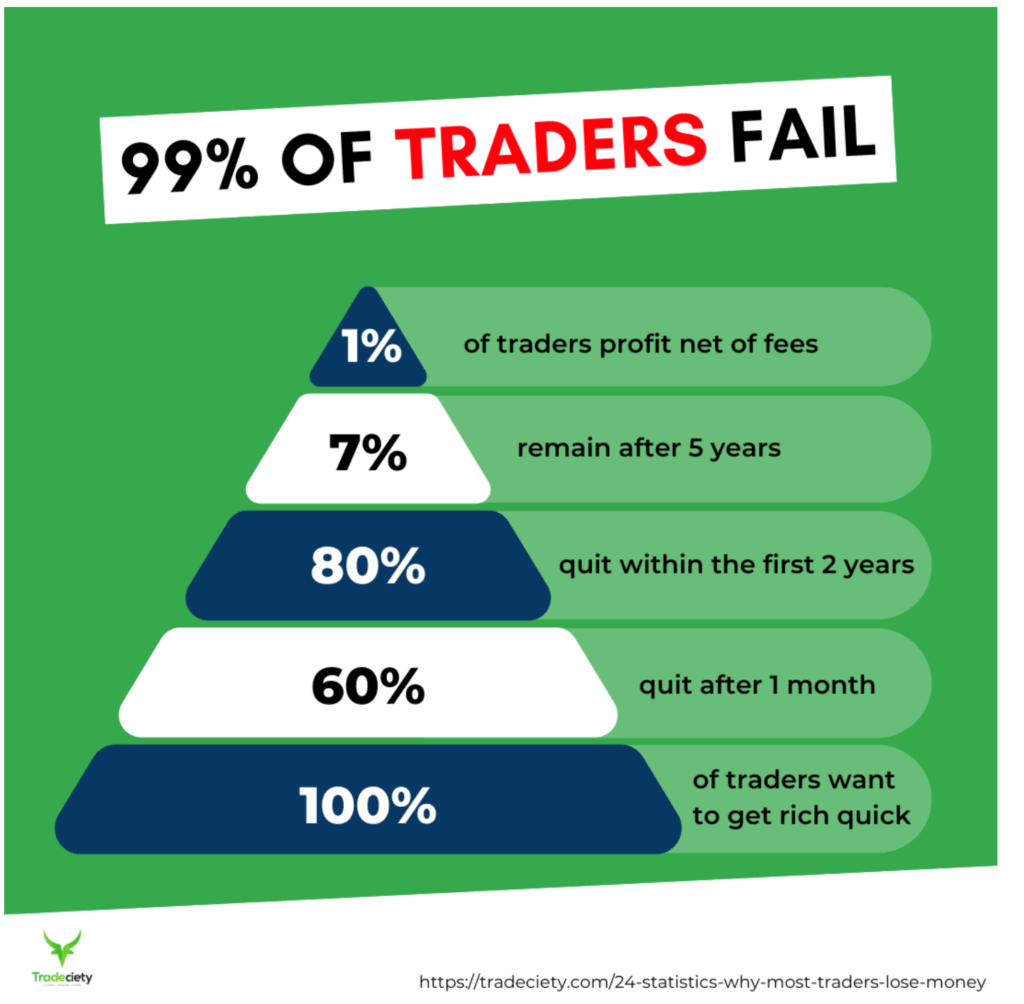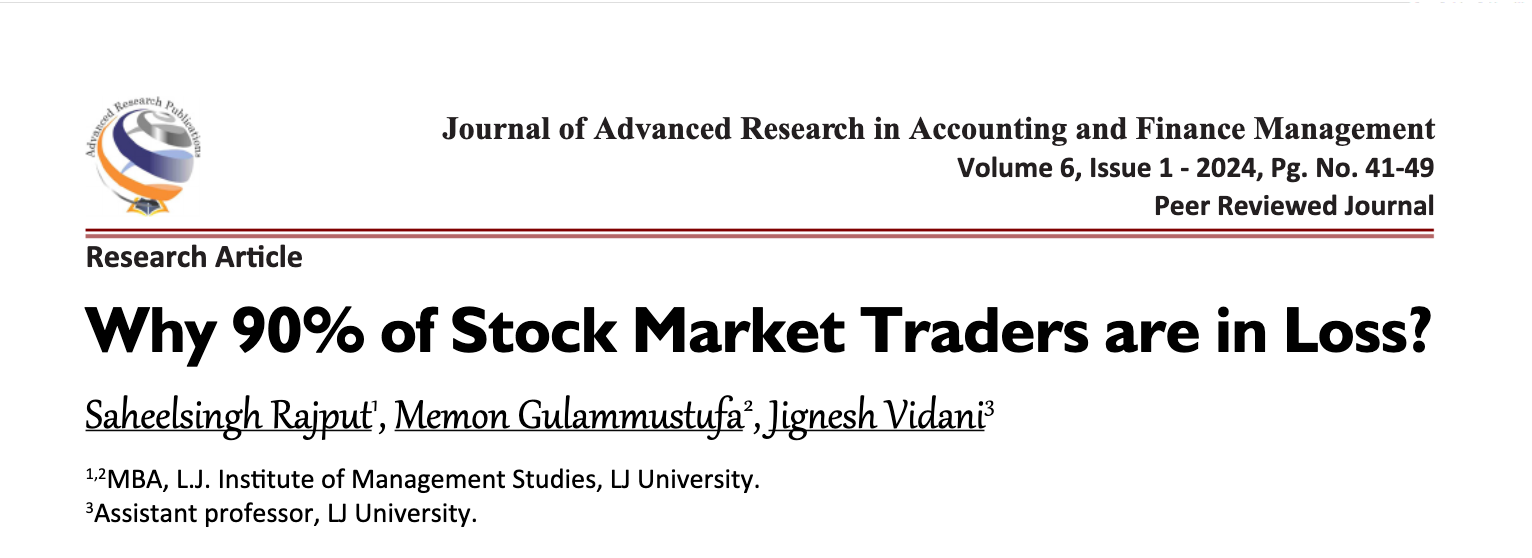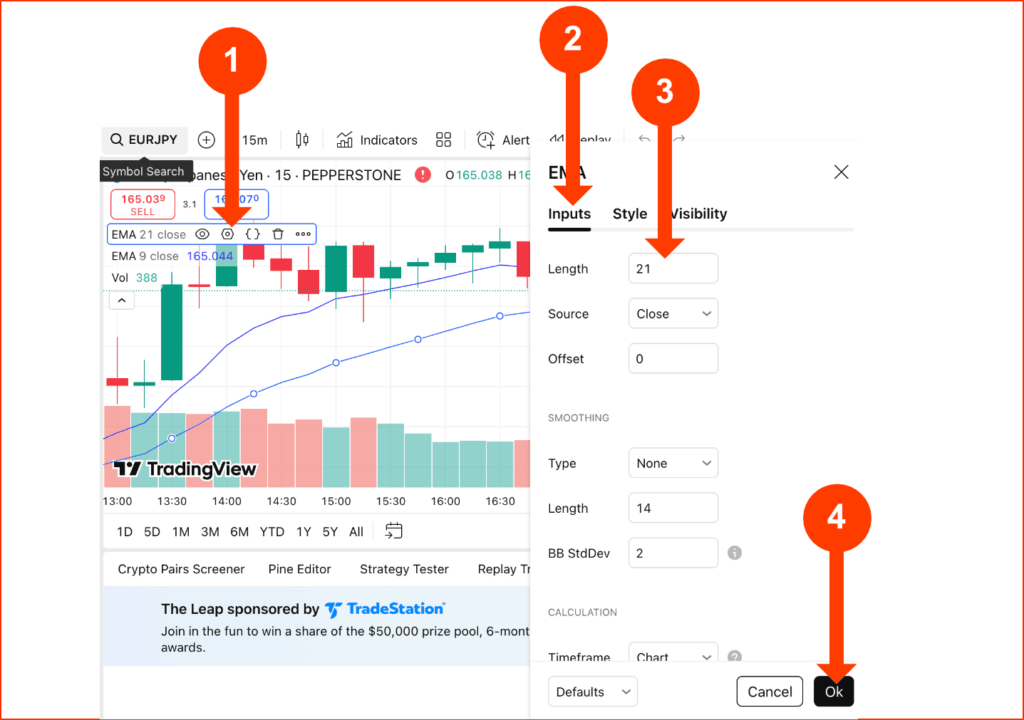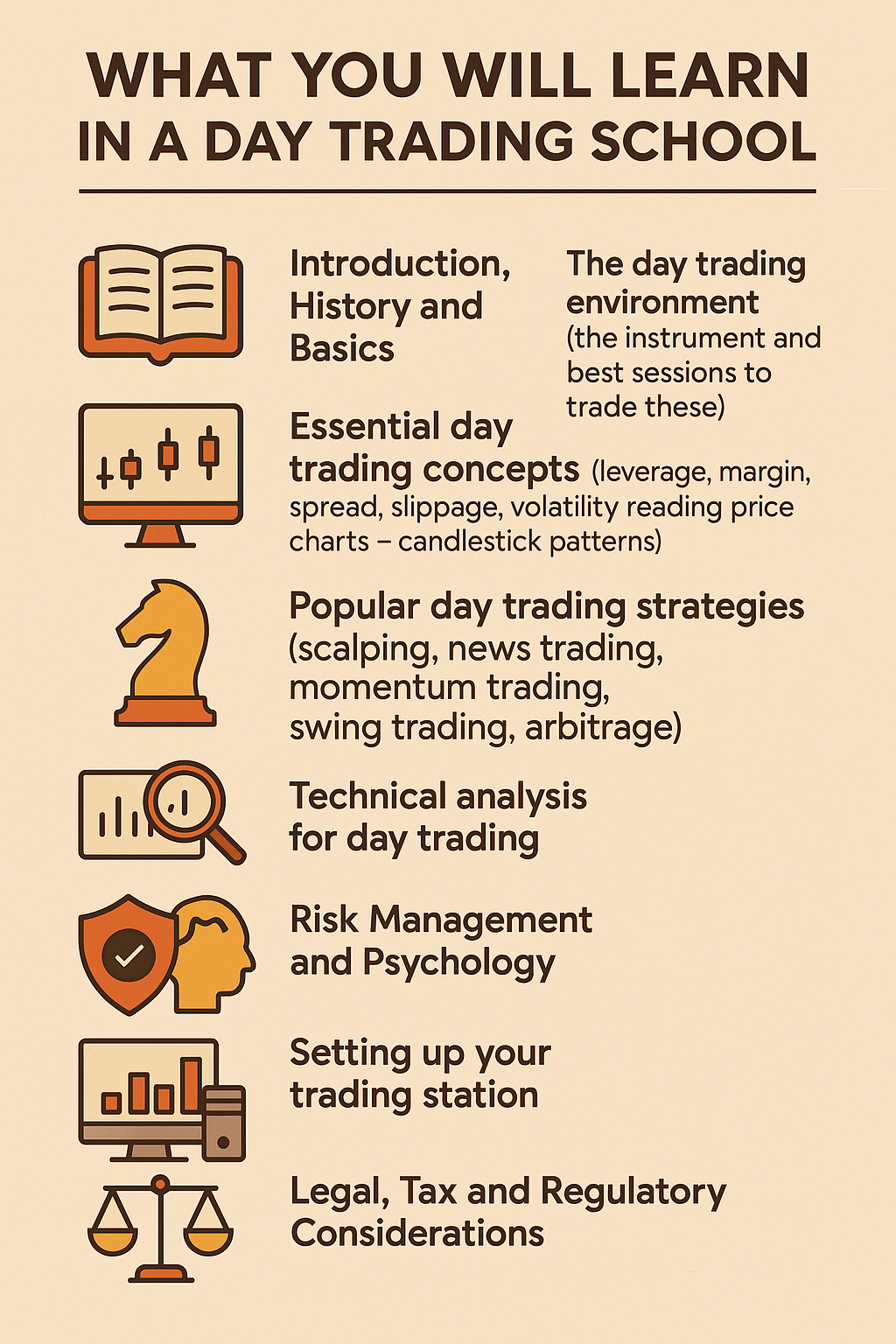
Warning! This is an epic long post, the reason being, I’m sharing a comprehensive beginner’s guide on 11 ways to make money in forex without actually trading. The first part of the post explores 11 models of generating income from this coveted niche and the last part is a practical and actionable guide you can follow to get started with this. TODAY!!!!!!!
How Big is the Forex Industry
Since 2010, the forex industry was often conceitedly referred to as a $4.0 trillion a day market. Fast forward to 2024, and according to the latest BIS Triennial Survey, global forex trading now averages over $7.5 trillion daily.
This is how big this industry is, and you too can get your share. You do not have to plan to be the next overnight forex millionaire, but this world is so big you can grab a market share big enough to fulfill your goals.
The cyber sphere is abuzz with the forex vogue so much that it is unusual to surf around without coming across ads and headlines about getting into forex — even more so if you’re exploring genuine ways of making money online.
Forex is indeed a high-risk, high-reward industry that rewards quite generously those who pay the price of mastering the ins and outs of this business.

Sad to say; the industry has claimed scalps of many casualties who dive into the deep end without paying due diligence towards gaining a good grasp of how to trade forex profitably.

This post, however, is not about candlesticks, scalping, news or any technical analyses and forex trading strategies. The post will expose 11 ways you can make serious money in the forex industry without necessarily trading forex.
And by the way — if you’re already curious about what today’s top traders use for their analysis and execution, platforms like TradingView have become indispensable for charting and strategy testing, while brokers like Pepperstone and IC Markets remain some of the most reliable names for those serious about navigating the forex space — whether as traders or through other roles you’ll discover in this guide.
Who said anything about quick money schemes (scams)? 😊 That is exactly what this article is NOT about.
Making Money with Forex CPAs
CPA in forex affiliate marketing stands for Cost Per Acquisition. The forex industry is quite vast. Many forex trading brokerages are selling trading software while running various campaigns to attract new traders onto their trading platforms and brokerage services.
These companies are willing to pay you a great deal of rewards for helping them attract more clients for their brokerage services.
Earning from CPAs can be pretty easy but this depends on the conditions of the CPA. Some brokerages will pay you around $150 to $600 for referring a prospective lead. Recognizable actions can be your referred client signing up for a live account or your referred client making a forex trading deposit.
Other service providers will pay you when your referred client purchases the forex trading platform. As a shrewd affiliate, you need to lower your magnifying glass on the conditions so as to ascertain the terms of the CPA. The current industry-standard has risen to $250-$500 per client, with the threshold going up depending on the size of the deposit or region.
Notably, top-tier brokers like Pepperstone and IC Markets run some of the most reliable and rewarding CPA and hybrid affiliate programs in the industry, making them worthwhile options for anyone looking to monetise through this channel.
AdSense
AdSense is an advertisement publishing program by Google. AdSense enables website owners and publishers to strike ads publishing arrangements with Google.
Google does not own the internet, surprise, surprise! Among other products and services, Google owns its search engine and, followed by Bing and Yahoo, Google remains the biggest search engine based on its global search market share.
Forex commerce is a booming industry and many companies are using the Google advertising program (Google Ads) to advertise forex and stocks trading brokerage services. This milieu has resulted in cut-throat competition for visibility in this business, making the forex niche one of the highest paying AdSense niches for web owners and publishers.
Many AdSense niches average $0.5–$1.5 CPC (Cost Per Click) but if you have a forex blog, you can still get over $40 per click in this lucrative niche, especially if your content targets trading tools and broker comparison guides.
Take note that AdSense earnings are determined by various factors such as CTR (Click Through Rate), blog age, and the source of traffic, among others. In any case, forex remains a highly rewarding AdSense niche for dedicated bloggers who are willing to play by Google’s rules to reap maximum rewards from this income strategy.
Selling Affiliate Programs
Forex brokers and experts are selling their programs over the internet and they are looking for strategic marketing partnerships they can leverage to actualize and catalyze the success of their strategies. Many brokerages sell their services through digital marketplaces such as Amazon and Clickbank. Most of these entities will offer commissions of up to 75 percent to affiliates.
Many blog owners are making thousands of dollars per month, some per day, selling affiliate forex-related products. What you should keep in mind is that forex is a thriving industry and there’s keen interest all round. Beginners are looking for quality forex eBooks, indicators, and educational resources to learn the ins and outs of this industry.
If you have a quality blog related to forex trading, your blog readers would be glad to purchase some of the great forex resources through your affiliate links.
Tools like TradingView Pro plans, broker accounts like Pepperstone’s Razor Account, or premium EA bots from reliable providers are currently popular high-converting products in the affiliate market.
If you’re interested in this route, take a look at some of the bestselling forex products on Amazon and Clickbank, as well as affiliate programs directly from leading brokerages and trading tool platforms.
With each affiliate product, you will typically get full support and marketing material from your service provider. All you need to do is directly convert referrals to these products and just sit back and count your commissions.
Rebates
Forex companies and brokers have various models for rewarding affiliates for the business they bring. One of these models is the rebates system. As an affiliate, you get compensated based on the trading volume generated by the clients you refer.
Many forex brokerages work in such a way that you can earn a portion of the spread or a fixed rebate — commonly around 0.5 to 2 pips — for every standard lot traded by your referred clients.
Put in layman’s terms, this means you can earn passive income from the trade activity of your referrals without executing any trades yourself.
Top brokers like Exness, Pepperstone, and IC Markets currently run rebate programs with competitive rates and transparent real-time reporting, making this one of the more reliable recurring income options in forex affiliate marketing.
Revenue Sharing
This model is a slightly gray area in the sense that it can straddle ethical lines, depending on broker practices. Technically, though, revenue sharing is one of the cleanest and most scalable ways of earning forex affiliate income without trading yourself.
In this model, market makers profit from the spread and — in some cases — a portion of client losses. What’s important to grasp is that enormous amounts of money are won and lost daily in the forex market, and not every dollar lost disappears into thin air.
As an affiliate, you can partner with brokers who offer a percentage of their net revenue per client you refer, earning a portion of spreads, commissions, and sometimes trading losses. While not every brokerage is transparent about this model, those that are often pay out handsomely to their top-performing affiliates.
The CPL Model
In affiliate marketing, CPL stands for Cost Per Lead. In this model, you get paid for each referral you make who submits their personal and contact details — such as name, email, and phone number — to the brokerage.
Brokerage service providers value this information as marketing intelligence data, especially when it’s collected from a contextually relevant blog or platform. If your blog or site deals with forex trading, you’ll be sending highly targeted leads to your affiliate partner, and you get rewarded for each one, whether or not they ever trade.
Typical CPL rates in the forex space now range from $20 to $150 per qualified lead, depending on the market region and broker.
Direct Referrals
This model works similarly to the CPL model, but with additional conditions. Here, brokerages compensate you for referrals at different stages of their customer journey.
Some brokers pay for each referral who signs up for an account, even without depositing. Others require that your referrals fund their accounts and start trading before you qualify for commissions — typically through CPA or revenue-share deals.
The flexibility of this model means you can mix and match your affiliate strategy based on your traffic type and audience quality.
Internet Partner Programs
Some forex trading companies offer internet partnership programs designed for affiliates aiming to scale up their earnings. With these programs, affiliates receive compensation through a mix of pips per transaction and multi-tiered structures.
For example, LiteFinance (formerly LiteForex) offers partnerships where you can earn up to 2 pips per transaction, translating to about $20 per standard lot traded. Some programs also allow multi-level partnerships, where you earn not just from your direct referrals, but also from the clients your referrals bring in, broadening your earning potential over time.
If you’re serious about building a forex affiliate income stream, partnering with brokers offering such tiered structures and advanced tracking tools can take your affiliate business to the next level.
White Label Programs
Ever heard of a White Label Program? It’s a system where you can market the products and services of a forex company under your own brand or trademark. Essentially, you run your own forex-branded platform — handling client acquisition, education, and marketing — while the actual trade execution and backend operations are managed by the main brokerage.
Think of it as affiliate marketing on steroids. You establish an authority website or trading community, position yourself as a reputable brand, and generate high-quality leads for your white label partner. In return, you typically receive a commission on every trade your clients make, often through spreads, markups, or revenue shares.
Brokers like LiteFinance, Exness, FXOpen, and Tickmill currently offer robust white label solutions, with options for tailored trading platforms, branded client areas, and localized payment systems.
PAMM Partnerships
PAMM stands for Percentage Allocation Management Module, a popular forex investment model where investors allocate their funds to professional traders (account managers) who trade on their behalf.
As a PAMM partner, you earn commissions by referring both investors and account managers. You also get a cut of the fees generated by the PAMM accounts you help promote. This model is particularly suitable for affiliates with active finance blogs, YouTube channels, or trading communities.
Some brokers, like RoboForex, Alpari, and LiteFinance, offer well-structured PAMM programs. Commission rates vary, but top-performing affiliates can earn between 40% to 65% of the management and performance fees generated by their referred clients.
Regional Representative Programs
Many forex companies — such as Exness, Tickmill, and FXOpen — actively recruit regional representatives to promote their services locally. As a regional rep, you act as the local face of the brokerage, providing client support, consultations, event hosting, and education sessions in your area.
Compensation structures vary by broker:
- Some pay monthly stipends plus commissions.
- Others offer performance-based commissions only.
A few brokers structure payments around client deposit volumes and active traders acquired through your office.
It’s an ideal model for affiliates with strong local connections or those interested in running forex workshops, seminars, or networking events.
A Quick Reality Check
While these models sound lucrative, always remember: not every affiliate program is created equal. Before partnering, read the fine print, verify the broker’s regulatory status, and watch out for overhyped online reviews — many are posted by unscrupulous brokers chasing quick affiliate sign-ups.
Due diligence is critical. Focus on brokers with a proven track record, clear payment structures, and transparent affiliate reporting systems.
Recommended Forex Affiliate Programs (2025)
Here’s a list of credible, active forex companies offering top-tier affiliate programs today:
How to Get Started as a Forex Affiliate Marketer
There you have it. You’ve seen the different models available for earning as a forex affiliate — and you’ve probably noticed that most of them assume you have your own blog or website.
That’s because affiliate marketing thrives on online referral activity, and having your own platform gives you control over your brand, content, and audience.
If you’re serious about generating consistent, genuine income online, getting a blog is your first foundational step.
Step 1: Choose a Blogging Platform
You’ve got two options:
Pre-hosted platforms like WordPress.com or Blogger.com (previously Google Blogspot).
These are free and easy to set up. Perfect for beginners testing the waters. However, your control over monetization, customization, and advanced SEO features is limited because your blog runs on their servers.
Self-hosted WordPress (WordPress.org).
This is the go-to solution for serious online entrepreneurs. You download the free WordPress software and install it on your own hosting account. It’s highly customizable, fully monetizable, and puts you in total control of your content and branding.
Step 2: Get a Domain and Hosting
It’s not rocket science — and it’s affordable too:
Domain registration costs around $10–$15 per year.
Hosting services for small startup blogs cost about $3–$8 per month. Reputable hosting providers like Bluehost, Namecheap, Hostinger, or SiteGround offer one-click WordPress installations, or you can ask their support team to install it for you.
Once installed, you can browse thousands of free and premium WordPress themes to give your blog a clean, professional, and modern look.
Step 3: Keyword Research — Don’t Skip This
This is where 90% of new bloggers fail. You can create the slickest, best-written forex blog in the world, but without traffic, it means nothing.
Keyword research is the heartbeat of online marketing success. It helps you identify what your target audience is searching for, and the terms you can rank for with relative ease.
You’re aiming for:
- High search volume
- Low to medium SEO competition
If you have a decent budget, head over to freelance platforms like:
- Upwork.com
- Freelancer.com
- PeoplePerHour.com
and hire someone for targeted keyword research in your chosen forex niche (PAMM investing, forex trading tools, forex education, etc).
If your budget is tight, check out Fiverr.com — for as little as $5–$20, you can get keyword research, blog setup, or even content writing services. Just be sure to read seller reviews and look for verified buyers to avoid low-quality gigs.
Step 4: Start Publishing Valuable, Unique Content
Once your blog is up and your keywords are ready, start creating valuable forex-related content:
- Trading guides
- Market analysis posts
- Reviews of forex brokers and affiliate programs
- Educational articles for beginners
Then embed your affiliate links naturally within those articles, guiding readers toward the brokers and services you’re promoting.
Final Tip: Build for the Long Game
Affiliate marketing isn’t a “get-rich-quick” model. Consistency matters.
Aim to:
Done right, you can build a long-term, income-generating forex affiliate business without needing to trade yourself.
Forex Affiliate Marketing Case Scenario: Real-World Inspiration
As promised, here’s a classic case scenario to get your ideas flowing.
A New Zealander by the name of Campbell once made around $10,000 a month in the forex niche — and interestingly, he wasn’t actively trading forex himself. Instead, one of his top-performing sites was a forex trading robots review website where he shared hands-on, user-based reviews of automated forex trading software.
His readers would visit his site to learn about different forex trading bots, get honest feedback, and discover which brokers and tools to use. When those readers made purchase decisions based on his recommendations, Campbell earned affiliate commissions on every sale.
That’s the power of niche affiliate marketing. Provide value. Solve problems. Get paid.
The Takeaway
If you’ve read this far, it means you’re serious about making this work for yourself — and that’s a good thing. The only thing standing between you and real online income is action. Avoid the trap of endless research and overthinking. You don’t need to know everything to get started — you learn best by doing.
I’ve basically unpacked every actionable strategy you need:
- Choose your affiliate model
- Set up your blog
- Do your keyword research
- Create valuable content
- Drive targeted traffic
- Optimize and monetize
- Pick your lane and commit.
Remember, many have walked this road before you. The biggest hindrance isn’t the challenges you’ll face — it’s the lack of ideas or courage to tackle them. But with so many tools, free resources, and guides out there, you’re far more equipped than you think.
Liked This Post?
If you found this useful, chances are someone else in your circle will too. We’d appreciate a share on Facebook or a follow on Twitter. Use the social media buttons below and spread the love.
Elias Stroud is a professional forex trader and market analyst with over eight years of experience. His journey began with the common misconception that trading was a get-rich-quick scheme, a path that led to significant early losses. It was this initial failure that forced a pivot towards disciplined, long-term learning and strategy development.
Today, Elias specializes in price action analysis, focusing on identifying high-probability setups without relying on complex indicators. He has cultivated a premium-level trading account, a direct result of his commitment to a structured and professional approach to the markets. Elias is passionate about sharing the actionable insights and foundational principles that helped him transform from a novice to a consistently profitable trader.
For further verification of his professional standing and live trading credentials, please visit the “About Us” page where account confirmation screenshots are provided, along with links to his trusted broker, Pepperstone, and his primary charting platform, TradingView.


